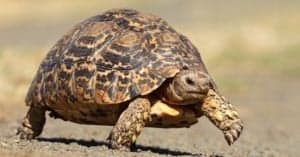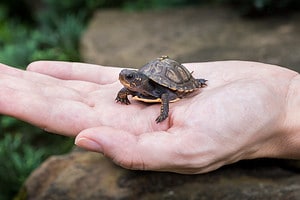The chain of islands making up Hawaii is home to a myriad of beautiful and interesting creatures. From stunning birds to unique fish and aquatic mammals, the Hawaiian islands support more than 22,000 species of plants and animals. Roughly 90% of these species living on the land are endemic to Hawaii. That means they are only found there. Some of the most exciting animals found in Hawaii are sea turtles!
With five different species nesting on the shores and living in the water, Hawaii is an amazing place to see them. In fact, Hawaii makes the top 10 list of best places to see sea turtle hatchlings in Summer. Without further ado, let’s learn more about sea turtles in Hawaii!
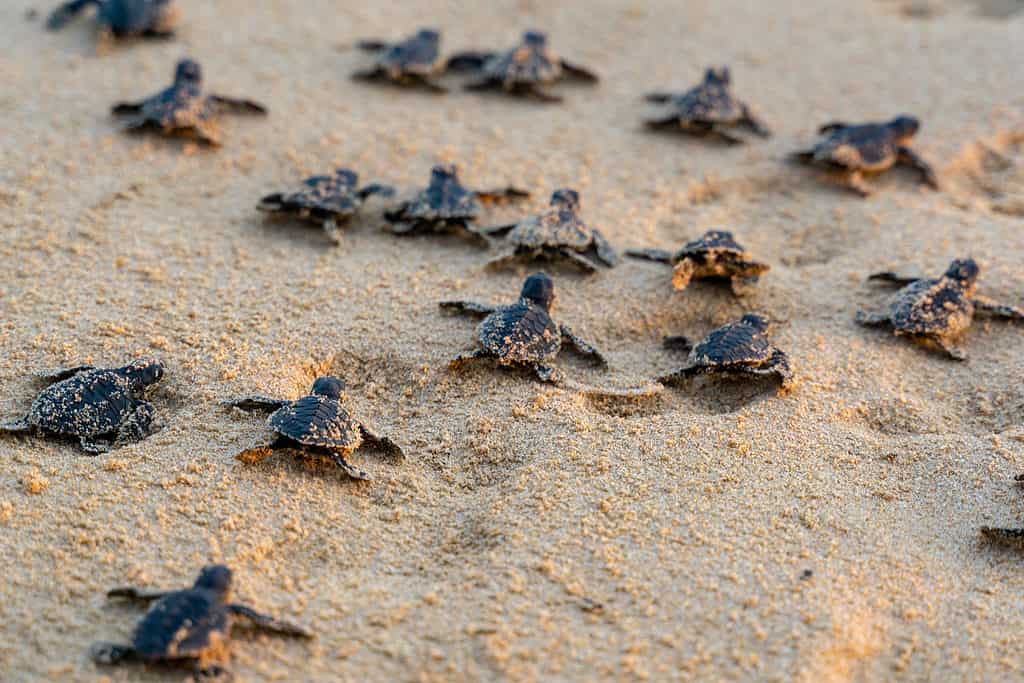
Sea turtle hatchlings follow their instinct to get to the ocean as fast as possible.
©Julian Wiskemann/Shutterstock.com
What Kind of Sea Turtles Live in Hawaii?
Five of the seven species of sea turtles live in Hawaii. The species found here include green, hawksbill, leatherback, loggerhead, and olive ridley. Females come ashore to lay eggs, usually on the same beach where they hatched. They lay roughly 100-200 eggs in each of 3-7 different nest sites. This process gives greater chances for their babies to make it to the ocean.
The eggs hatch sometime in the night anywhere from 6 to 100 days later, depending on the species. The hatchlings make a mad dash for the ocean. Unfortunately, only one in 5,000 hatchlings survive to adulthood.
By and large, sea turtles don’t reach sexual maturity until about 20-30 years old! That puts them at a great disadvantage when it comes to breeding and reproducing. It also contributes significantly to the poor recovery of sea turtle populations that have become endangered.
Now that we learned a little more about sea turtles in general, let’s explore details about each species of sea turtle that lives in Hawaii!
Green Sea Turtles
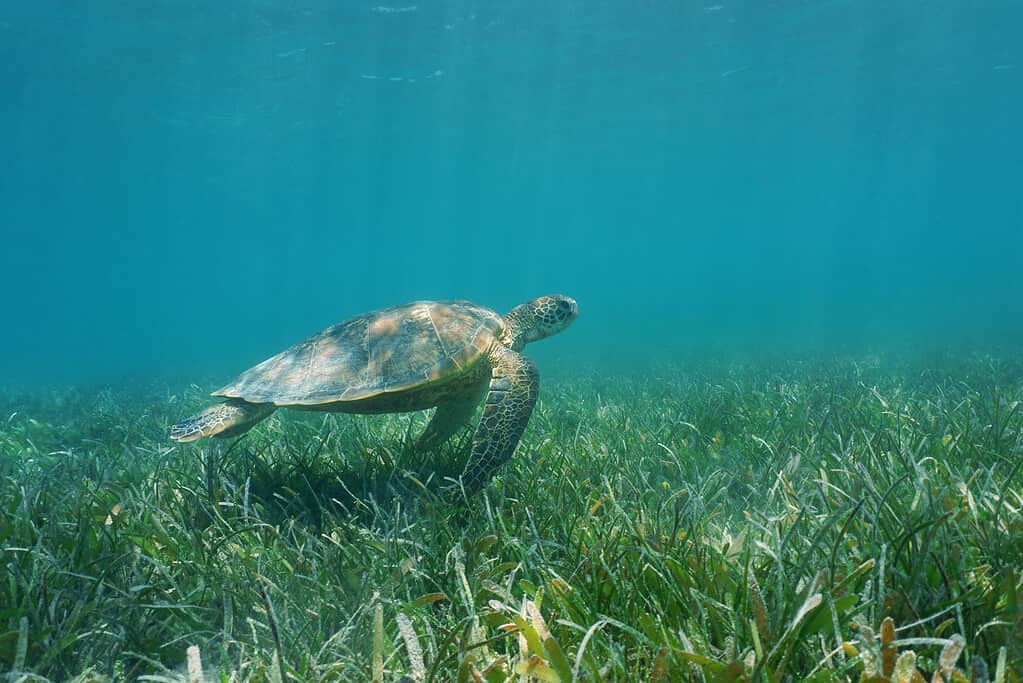
Green sea turtles are among the most commonly seen in Hawaii.
©Damocean/iStock via Getty Images
Called Honu by the locals, green sea turtles are the most commonly seen species in Hawaii. Funnily enough, they aren’t actually green on the outside! Their name comes from the green color of their fatty tissues caused by their exclusively plant-based diet. They are the only herbivorous sea turtle species.
Although they rarely come together in large groups, individuals frequent the bays and offshore reefs. The sea turtles come to this area to feed on algae and bask in the sun on the sand. Tourist attractions on the Island of Maui even offer the opportunity to snorkel with these amazing creatures!
Green sea turtles in Hawaii reach lengths of up to 5 feet and weigh up to 500 pounds. However, the average weight is about half of that. They travel several hundred miles from their home beaches and do not return until they reach maturity. After that, they still only return to mate or nest about every 2-7 years.
When they aren’t mating or nesting, they spend most of their time foraging for food in nearly every major ocean across the world. These turtles live long lives, up to 80 years! They usually breed in late spring.
Hawksbill Sea Turtles
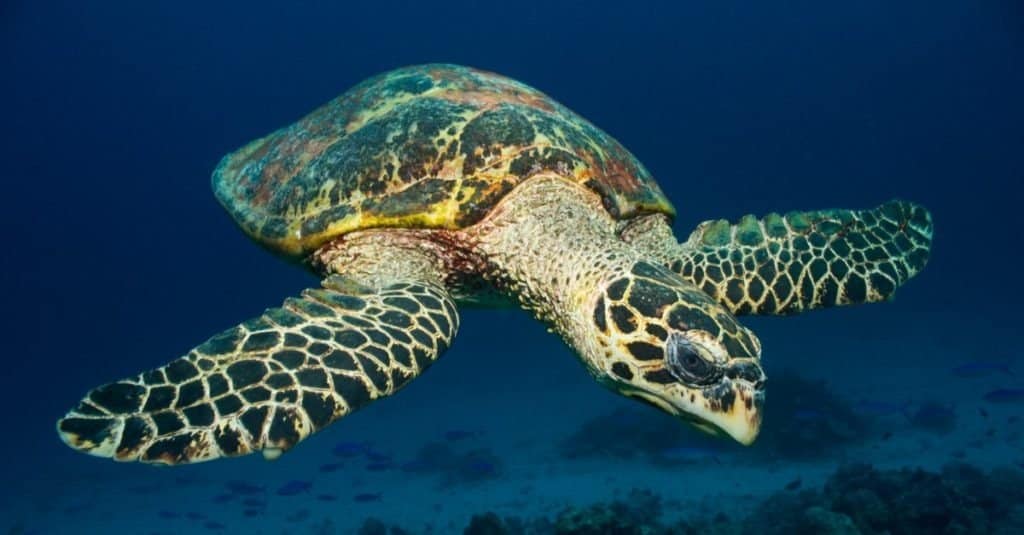
Hawksbill sea turtles are one of the species critically endangered due to poaching.
©John Back/Shutterstock.com
Named for their sharp, beak-like mouth similar to a hawk’s, this type of sea turtle hunts along the coral reefs in Hawaii. Called honu‘ea by Hawaiians, they eat sea sponges, algae, squid, sea urchins, and even jellyfish. One of the smaller sea turtle species, hawksbills only reach about 4 feet in length and around 200 pounds.
In the United States, these sea turtles nest primarily in Hawaii, where 10-25 females appear annually. On the other hand, on eastern shores from Mexico to Peru, approximately 700 females come to nest each year. These sea turtles also swim long migration routes outside of Hawaii, but the ones living there tend to stay around the islands. Females lay up to 180 eggs per nest (1-5 clutches per season) and breed every 2-7 years or so. Nesting begins around May and continues through October, with hatchlings making their ocean-seeking dash as late in the year as December.
Hawksbills spend most of their time foraging for food among coral reefs when they’re away from the breeding grounds. They inhabit all the major oceans worldwide, often found resting in underwater caves and on rock formations.
While the hawksbill sea turtle is a protected species in Hawaii and around the world, they are critically endangered due to poaching. The turtles are prized for their beautiful shells, which are sold to make jewelry and other decorative items.
Leatherback Sea Turtles
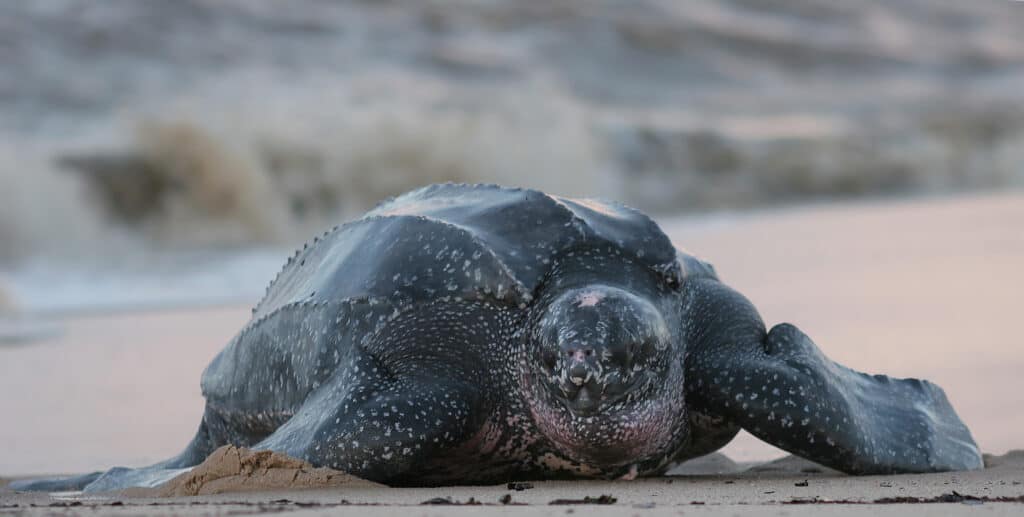
Leatherback sea turtles live in every ocean in the world except the Arctic and Antarctic.
©Stephanie Rousseau/Shutterstock.com
Found in every ocean except the Arctic and Antarctic, leatherback sea turtles also call Hawaii home. They have the largest global distribution of any sea turtle species, but in recent years, their population has been quickly declining. Most scientists attribute this to bycatch (accidentally being caught in fishing nets), turtle/egg hunting, and ocean pollution.
These incredible leatherback sea turtles have both the longest migrations (over 10,000 miles) and deepest swimming depths (up to 4,000 feet) of any sea turtle species. While they live all over the world, these sea turtles do not typically nest in Hawaii. The largest collective nesting grounds remain in Trinidad, Tobago, West Indies, and Gabon, Africa. They spend most of their lives at sea, eating jellyfish and salps.
While they don’t nest there, they do travel to the Hawaiian islands in search of food. One of the most likely places to see them in Hawaii is Panalu’u Beach on the Big Island.
Leatherback sea turtles, named for their soft, leathery shells, mature more quickly than others. They reach breeding age at 9-20 years old and live to about 50 years old. Females nest every 2-4 years and lay in several nests each time they breed. Like other sea turtles, they face threats from humans along with natural predators like sharks.
Loggerhead Sea Turtles
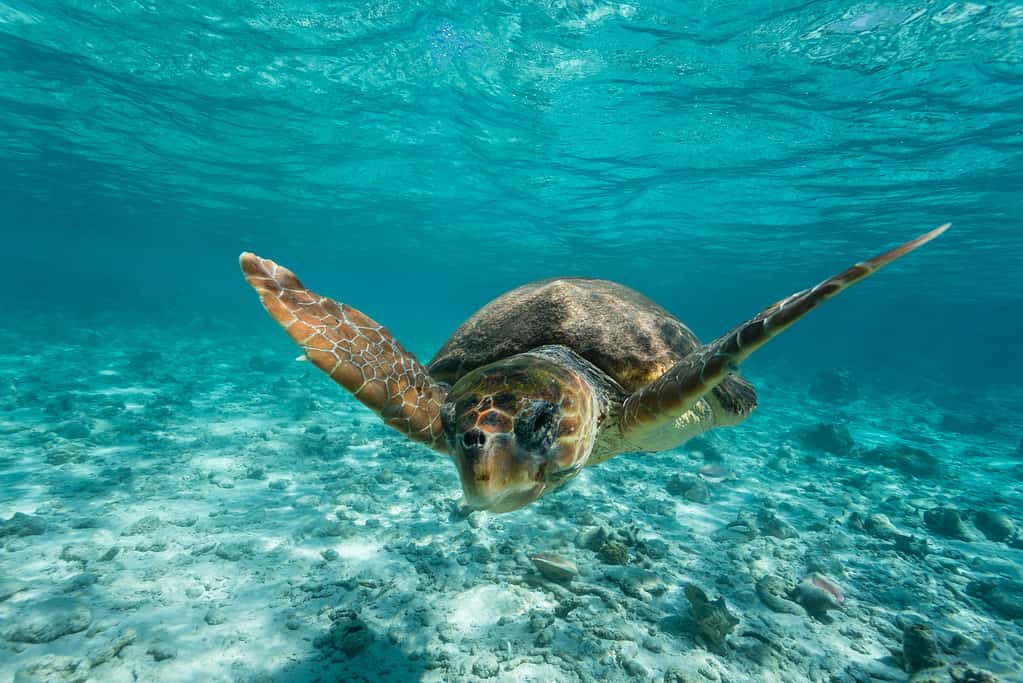
Named for their large heads, loggerhead sea turtles are the most abundant species in the U.S.
©pniesen/iStock via Getty Images
The loggerhead sea turtle claims the title of the most abundant sea turtle in the United States. Named for their rather large heads, these turtles have powerful jaws that allow them to crush hard-shelled prey like whelks and conch. They reach maturity around 35 years old and mate every 2-3 years in late March to early June. Then, females lay in late April to early September. The largest nesting sites for loggerhead turtles are found in South Florida. These sea turtles do not normally nest in Hawaii.
Interestingly, the gender of the babies is altered by the temperature of the sand in which the eggs are laid. Cooler sand makes males, while warmer sand makes females. How cool is that?
This species also lives longer than the others, up to 80 years or more. You can sometimes see loggerhead sea turtles in Hawaii on the island of O’ahu at Laniakea Beach.
Olive Ridley Sea Turtles
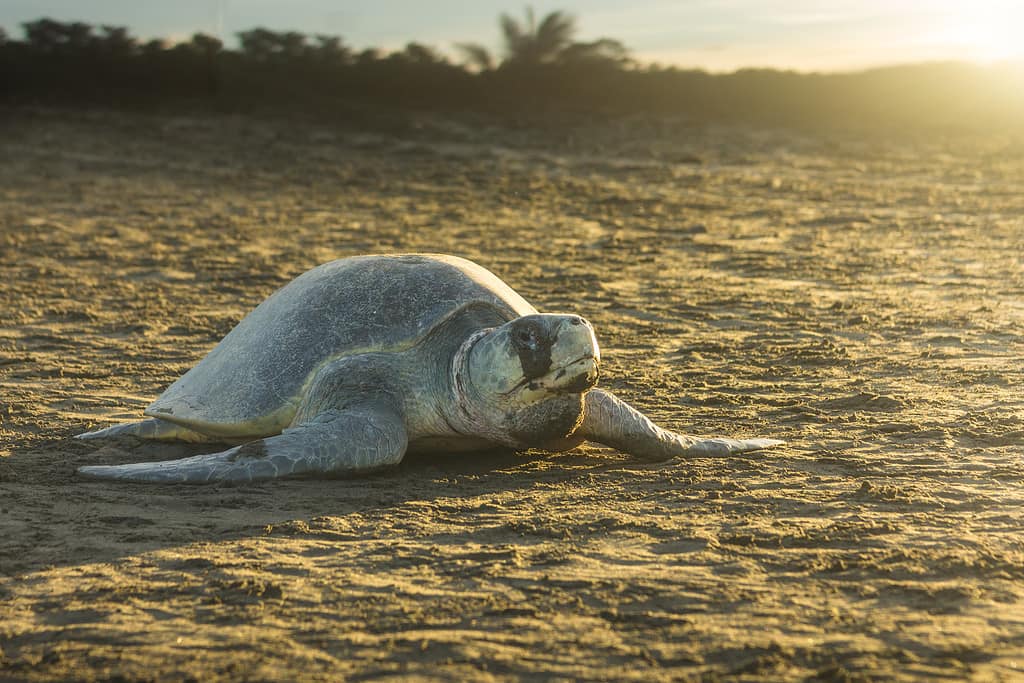
Olive ridley turtles are one of two species that participate in arribada, a mass nesting event.
©Daniel Alvarado Calderon/iStock via Getty Images
Named for its olive-colored, heart-shaped shell, the olive ridley sea turtle is seen in Hawaii only rarely. That’s because they tend to prefer the deep, open ocean.
Even so, in 2019, the National Oceanic and Atmospheric Administration (NOAA) reported the sixth olive ridley sea turtle nest in Hawaii to be found in the last 30 years. The more interesting part was that the nest was discovered on O’ahu, where very few sea turtles of any species make their nests. This nest was an extremely rare and strange occurrence since olive ridley sea turtles frequently participate in arribada. This is the term for the mass gathering of female turtles at a communal nesting site. The only other sea turtle species that do this is the Kemp’s ridley sea turtle.
Olive ridley sea turtles have also been observed making solitary nests in about 40 different countries around the world. Scientists don’t know why arribada occurs. They suggest it might be due to moon cycles or even pheromones released into the water by females ready to lay that attract others.
These sea turtles dive up to 500 feet in search of food such as algae, lobsters, crabs, and mollusks. At this time, it remains unknown how long these turtles live. We do know that they reach maturity around 14 years old. Like the loggerhead sea turtle, hatchling sex is determined by the temperature of the sand the eggs are laid in.
All 7 Species of Sea Turtles Are Endangered
An article about sea turtles just isn’t complete without at least briefly mentioning the threats they face. Habitat destruction, global warming, bycatch, vessel strikes, hunting, egg collection, and ocean pollution all pose significant dangers to sea turtles in Hawaii and worldwide. NOAA assists with species survival plans for all seven species and also publishes articles about what you can do to help sea turtles.
If you see a turtle nest of any kind on a beach, leave it alone. If you live in an area where sea turtles nest, find out when the hatching season starts and ends. Be sure to turn off your outdoor lights during this time. This will help hatchlings by not distracting them with artificial light. You can also join a turtle rescue and release program or donate to sea turtle programs near you!
The photo featured at the top of this post is © Achimdiver/Shutterstock.com
Thank you for reading! Have some feedback for us? Contact the AZ Animals editorial team.




